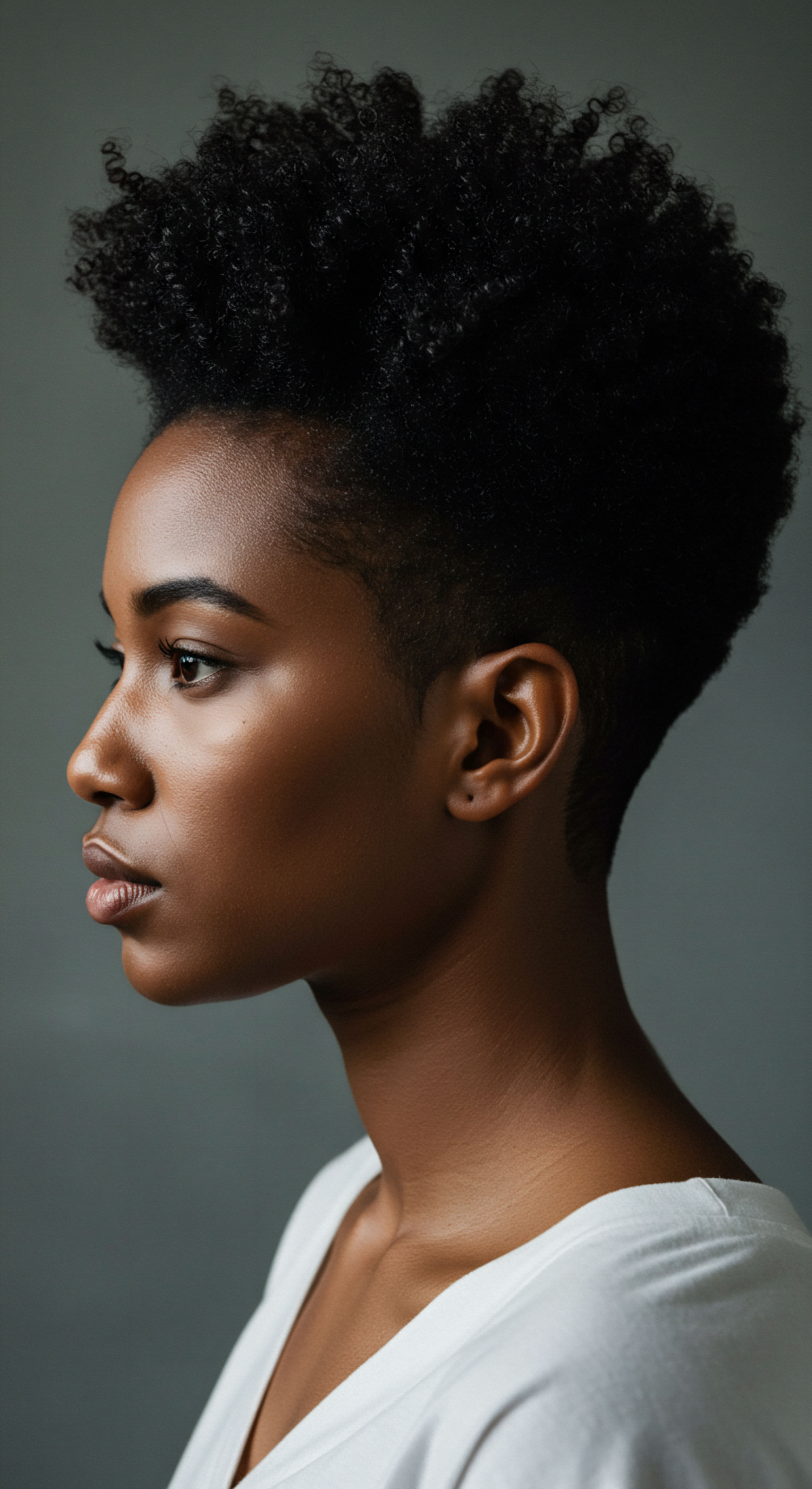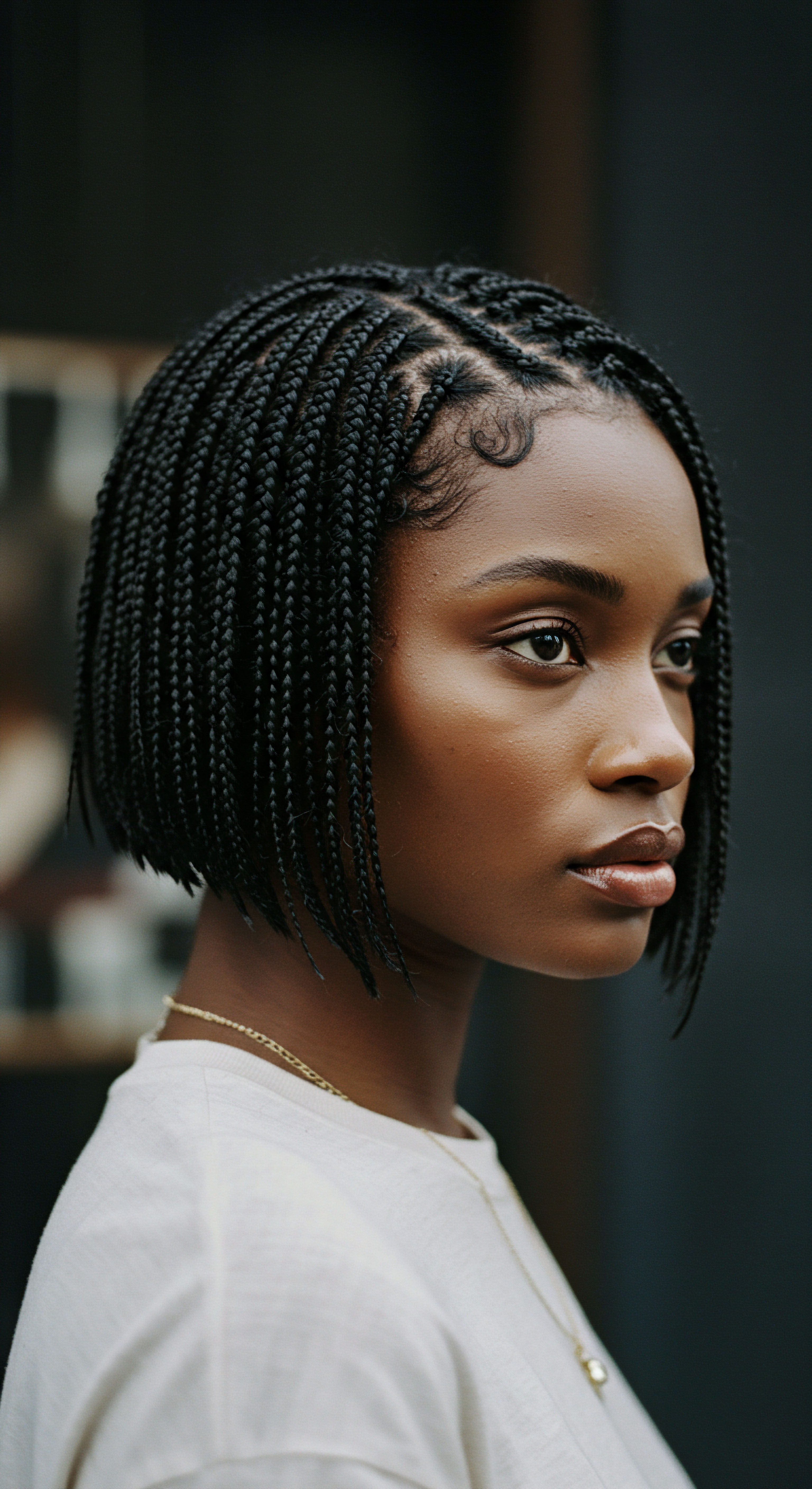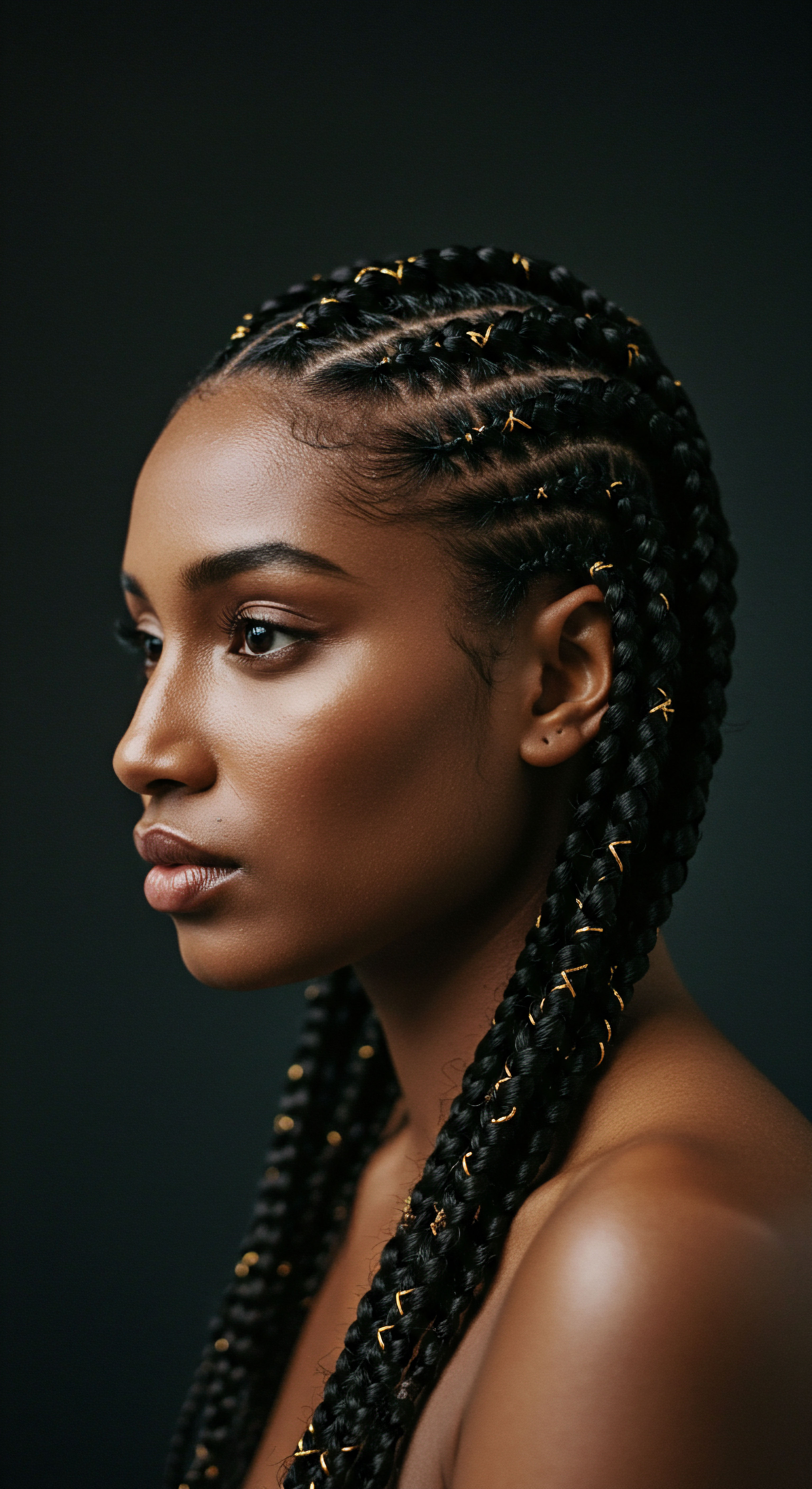
Roots
A quiet inquiry often surfaces when we consider the intimate connection between our scalp, our hair, and the coverings we choose to wear. For many, a head covering is a daily companion, a shield against the elements, a statement of identity, or a deeply held expression of faith. Yet, beneath these layers of fabric and meaning, a delicate ecosystem thrives—or sometimes, struggles.
Understanding the foundational elements of our hair and scalp is the initial step toward discerning how these layers interact, not just in fleeting moments, but over the course of time. This understanding begins with the very structure of hair and the vibrant world of the scalp.

Hair Anatomy and Physiology
Our hair, far more than simple strands, is a complex biological marvel. Each individual hair shaft, the visible portion extending from the scalp, consists of three primary layers ❉ the Cuticle, the Cortex, and in some cases, the Medulla. The cuticle, the outermost protective layer, resembles overlapping scales, much like shingles on a roof.
This resilient barrier safeguards the inner structures from external harm and regulates the hair’s moisture content. A healthy cuticle lies smooth and flat, lending hair its characteristic shine and offering a shield against environmental assaults.
Beneath the cuticle lies the cortex, comprising the bulk of the hair shaft. This layer, composed of long keratin protein chains, bestows hair with its strength, elasticity, and determines its color and curl pattern. The innermost layer, the medulla, is present primarily in thicker hair types and consists of a soft, thin core of transparent cells and air spaces; its precise role, however, remains somewhat unclear. The vitality of our hair, its ability to retain moisture and resist breakage, hinges significantly on the integrity of these layers, particularly the cuticle and cortex.
The hair shaft, a complex biological structure, relies on its layered composition—cuticle, cortex, and medulla—to maintain strength, moisture, and resilience.

The Scalp Microbiome and Its Delicate Balance
The scalp, a dynamic environment often overlooked, hosts a diverse microbial community, a living ecosystem of bacteria, fungi, and yeasts. This Scalp Microbiome, shaped by factors such as sebum production, moisture levels, and pH, plays a significant role in maintaining overall scalp health. A balanced microbiome contributes to a protective barrier against harmful microorganisms, regulating sebum and maintaining an acidic pH that deters the proliferation of various pathogens.
Specific microbial residents, such as the fungus Malassezia and bacterial species like Cutibacterium acnes and Staphylococcus epidermidis, coexist in this lipid-rich environment. While Malassezia, for instance, is a normal resident that thrives on sebum, an overgrowth can lead to common scalp conditions such as dandruff and seborrheic dermatitis. Disruptions to this delicate balance, often termed dysbiosis, can manifest as itching, irritation, and even hair loss. Maintaining this microbial equilibrium is paramount for vigorous scalp health and, by extension, the quality of the hair it produces.

How Does Hair Growth Cycle Relate to Covering?
Hair growth follows a cyclical pattern, a continuous process involving periods of active growth (anagen), transition (catagen), and rest (telogen). Each hair follicle operates independently, cycling through these phases. While head coverings do not directly interfere with the biological machinery of hair growth at the follicular level, external factors can influence the overall health of the scalp environment, which in turn supports or hinders healthy hair cycles.
For instance, a consistent environment of trapped moisture or heat beneath a covering might alter the scalp’s natural pH and sebum production, potentially affecting the microbiome and leading to conditions that can disrupt the normal hair cycle. Such disruptions might cause hairs to enter the resting or shedding phase prematurely, or impact the quality of new growth. A healthy scalp, characterized by proper blood circulation and a balanced microbiome, is a prerequisite for robust hair growth and retention.

Ritual
Our daily rituals, whether consciously chosen or deeply ingrained, sculpt the contours of our hair health. When we consider head coverings, we step into a space where personal habits meet material realities, where tradition often intersects with modern understanding. The very act of covering, a practice spanning cultures and centuries, brings with it a unique set of considerations for the scalp and hair beneath. This section explores the practical wisdom that emerges from this intersection, offering gentle guidance on how to care for textured hair while honoring diverse practices.

Material Matters for Hair Health
The choice of material for a head covering holds significant sway over the microclimate it creates for the scalp and hair. Fabrics such as Cotton, Silk, and Satin are frequently recommended for their breathability and gentle texture. Cotton, a natural fiber, permits airflow, helping to mitigate excessive heat and moisture buildup. Silk and satin, known for their smooth surfaces, minimize friction against hair strands, which can be particularly beneficial for textured hair prone to dryness and breakage.
Conversely, synthetic materials like nylon or polyester, while durable, often lack the breathability of natural fibers, potentially trapping heat and moisture against the scalp. This occlusive environment can create conditions conducive to bacterial or fungal overgrowth, leading to irritation, itching, or even conditions like folliculitis. A thoughtful selection of covering material is a foundational step in preserving scalp equilibrium and hair integrity.

Styling Under Coverings ❉ A Gentle Approach
The manner in which hair is styled beneath a head covering can profoundly influence its long-term health. Styles that exert constant tension on the hair follicles, such as excessively tight braids, buns, or ponytails, carry a risk of a condition known as Traction Alopecia. This form of hair loss results from repeated pulling on the hair, leading to damage to the follicles over time. For individuals with textured hair, which can possess fewer elastic fibers attaching hair follicles to the dermis compared to other hair types, this consideration becomes particularly relevant.
To mitigate this risk, embracing looser styles that distribute tension evenly or allow the hair to rest freely is advisable. Low buns or ponytails, rather than high, taut styles, can help reduce pressure on the scalp. Alternating parting lines and avoiding consistent pressure on the same areas can also offer relief to hair follicles. When clips or pins are necessary to secure a covering, changing their placement regularly can prevent localized stress.
Gentle styling beneath head coverings, prioritizing loose arrangements and varied tension points, helps guard against potential hair damage.

Cleansing and Airing for Scalp Vitality
Maintaining impeccable scalp hygiene becomes even more significant when wearing head coverings regularly. Trapped sweat, sebum, and environmental debris can accumulate, creating an environment ripe for imbalances in the scalp microbiome. Regular and thorough cleansing of both the hair and scalp is essential to remove this buildup and support a healthy microbial balance.
Equally important is allowing the hair and scalp ample opportunity to breathe and air out. Removing head coverings when indoors, especially in the evenings before sleep, provides the scalp with exposure to fresh air, aiding in moisture evaporation and preventing the prolonged dampness that can encourage microbial proliferation. This practice helps to restore the scalp’s natural pH and allows for optimal circulation, supporting the vitality of the hair follicles.
| Aspect of Care Material Choice |
| Consideration for Scalp and Hair Opt for breathable, smooth fabrics like silk, satin, or cotton to reduce friction and allow airflow. |
| Aspect of Care Styling Tension |
| Consideration for Scalp and Hair Select loose styles; avoid tight braids, buns, or ponytails that pull on follicles. |
| Aspect of Care Scalp Cleansing |
| Consideration for Scalp and Hair Regularly wash hair and scalp to remove sweat, sebum, and debris. |
| Aspect of Care Airing Practices |
| Consideration for Scalp and Hair Allow scalp and hair to air out regularly, especially indoors. |
| Aspect of Care Product Selection |
| Consideration for Scalp and Hair Choose gentle, pH-balanced products that support scalp microbiome health. |
| Aspect of Care Thoughtful choices in material, styling, and hygiene preserve scalp health under head coverings. |

Relay
Beyond the immediate tactile sensations and daily routines, the deeper layers of inquiry reveal how wearing a head covering can truly influence scalp health and hair quality over time. This exploration calls for a consideration of the interconnectedness of biological mechanisms, cultural practices, and even the subtle shifts in our internal ecosystems. It is a journey into the less apparent complexities, where science and lived experience converge to paint a more complete picture.

Can Prolonged Occlusion Affect Scalp Microbiome Balance?
The concept of occlusion, where the scalp is covered for extended periods, raises questions about its influence on the delicate microbial balance. The scalp, a sebaceous environment, thrives with a specific community of microorganisms. When this environment is consistently covered, factors such as increased temperature and humidity can alter its natural state. A study conducted in Indonesia, a tropical country where many women wear hijabs, sought to compare the scalp microbiome of healthy hijab-wearing women to those not wearing hijabs.
The researchers observed that women wearing hijabs tended to have more Staphylococcus capitis and Malassezia restricta on their scalps, while women not wearing hijabs showed a greater presence of Staphylococcus cohnii and Malassezia globosa. This suggests a potential shift in the microbial community structure under conditions of prolonged covering. The study hypothesized that this altered microbial landscape might predispose hijab-wearing women to certain inflammatory skin conditions, such as seborrheic dermatitis, more frequently than their counterparts.
While this research highlights a microbial difference, it also points to the scalp’s remarkable adaptability, with no significant differences found in scalp hydration or pH values between the two groups in this particular study. The presence of hair follicles and sebaceous glands, alongside the hair’s thermoregulatory role, may contribute to this adaptability.

Does Head Covering Contribute to Hair Loss Conditions?
The question of whether head coverings directly cause hair loss is one that frequently arises. Research indicates that casual hat wearing does not typically lead to permanent hair loss or damage hair follicles. Hair follicles derive their oxygen and nutrients from the bloodstream, not directly from the air, meaning a hat does not “suffocate” them.
However, a distinct form of hair loss, Traction Alopecia, can indeed be linked to head coverings, particularly when they are worn tightly or involve securing hair with excessive tension. This condition arises from chronic, repetitive pulling on the hair follicles, leading to inflammation and, over time, potential scarring and irreversible hair loss. This is particularly noted in communities where religious or occupational headwear is worn with consistent tension, such as the tight wrapping of a hijab, or the specific styling of a turban or dastar by Sikh men.
A significant data point underscoring this comes from a 2023 survey of 104 hijab-wearing Muslim women in New York City mosques. This study revealed that 34% of participants who wore a hijab for 7 to 9 hours daily experienced hair loss, a stark contrast to the 3% of those who wore a hijab for under 3 hours. This suggests a correlation between the duration of tight covering and the incidence of hair loss, likely due to the continuous tension exerted on the hair roots. It underscores that the issue lies not with the covering itself, but with the methods of securing it and the hairstyles worn beneath.

Beyond Physical Tension ❉ Other Factors at Play?
Beyond direct physical tension, other factors associated with head coverings might subtly influence scalp and hair health. A warm, humid environment created by certain coverings can foster an environment where sweat and sebum accumulate, potentially leading to scalp irritation or conditions like dandruff. While not a direct cause of hair loss, an irritated or unhealthy scalp can hinder healthy hair growth.
The practice of putting on a head covering over damp hair can also have consequences. Trapping moisture against the scalp for extended periods can lead to a weakened hair shaft, making it more prone to breakage and damage. This emphasizes the importance of ensuring hair is completely dry before covering.
Moreover, the historical and cultural significance of hair care, particularly within textured hair communities, often includes protective styling and the use of coverings, underscoring a deep understanding of hair preservation. These traditions, passed through generations, often incorporate practices that inherently seek to shield hair from environmental stressors and minimize manipulation, even if the underlying scientific mechanisms were not explicitly articulated in historical contexts.
| Area of Impact Microbial Balance |
| Possible Outcome Shift in scalp microbiome, potential for irritation or dermatitis. |
| Mitigation Strategy Choose breathable materials, ensure thorough cleansing, allow airing. |
| Area of Impact Hair Follicle Tension |
| Possible Outcome Traction alopecia, hair loss along the hairline. |
| Mitigation Strategy Opt for loose styles, vary tension points, avoid excessive tightness. |
| Area of Impact Moisture and Heat Trapping |
| Possible Outcome Damp scalp, weakened hair shaft, fungal growth. |
| Mitigation Strategy Ensure hair is dry before covering, use absorbent liners if needed. |
| Area of Impact Friction Damage |
| Possible Outcome Hair breakage, cuticle damage. |
| Mitigation Strategy Utilize smooth lining materials like silk or satin. |
| Area of Impact Understanding specific impacts allows for targeted strategies to preserve hair and scalp vitality. |

Cultural Significance and Practical Considerations
Head coverings carry profound cultural and religious significance for countless individuals globally. From the elaborate cornrows and threaded styles of African traditions, often protected by scarves, to the hijab, turban, or sheitel worn for religious observance, these coverings are far more than mere accessories. They embody identity, heritage, and a connection to spiritual beliefs.
Acknowledging this deep-seated meaning is essential when discussing hair and scalp health. The aim is never to diminish the importance of these practices, but rather to offer practical considerations that allow individuals to honor their traditions while also prioritizing their physiological well-being. This might involve thoughtful choices in under-caps, adjustments to hair styling beneath the covering, or adapting cleansing routines to accommodate the covering schedule. It speaks to a holistic approach where cultural sensitivity and scientific understanding coalesce for the greater good of hair and scalp health.

Reflection
The journey through the intricate world of hair and scalp, particularly as it relates to head coverings, reveals a landscape rich with nuance and interconnectedness. It is a space where the delicate biology of our strands meets the deeply personal choices of identity and expression. We have seen that while head coverings themselves do not inherently cause hair loss, the how of their wear—the materials chosen, the tightness of styling, and the diligence of care routines—can profoundly shape the long-term vitality of both scalp and hair.
The subtle shifts in the scalp’s microbial balance, the silent tension that can lead to traction alopecia, and the simple wisdom of allowing hair to breathe all point to a singular truth ❉ thoughtful, informed practices hold the key to maintaining scalp serenity and hair quality over time. This understanding, grounded in both scientific inquiry and a deep respect for cultural heritage, empowers each individual to cultivate a harmonious relationship with their hair, no matter how it is adorned.

References
- Alhanshali, L. Buontempo, M. G. & Bawany, F. (2023). Religious headwear and alopecia ❉ considerations for dermatologists. International Journal of Women’s Dermatology.
- Billero, V. & Miteva, M. (2018). Traction alopecia ❉ the root of the problem. Clinical, Cosmetic and Investigational Dermatology, 11, 149-159.
- Karimian-Teherani, D. & Fritz, S. (2005). Turban alopecia in Sikh men. Journal of the American Academy of Dermatology, 53(1), 148-150.
- Lee, Y. B. & Lee, W. S. (2020). The impact of daily hair grooming and scalp care on scalp health and hair growth. International Journal of Trichology, 12(4), 136-142.
- Madnani, N. & Khan, K. (2013). Hair cosmetics. Indian Journal of Dermatology, Venereology, and Leprology, 79(5), 654.
- Mols, F. et al. (2009). Impact of scalp cooling on chemotherapy-induced alopecia, wig use and hair growth of patients with cancer. European Journal of Oncology Nursing, 17(1), 1-5.
- Sleeman, M. (1981). Medieval Hair Tokens. Forum for Modern Language Studies, 17(4), 322-332.
- Synnott, A. (1987). Shame and Glory ❉ A Sociology of Hair. The British Journal of Sociology, 38(3), 381-403.
- Van den Hurk, C. J. G. van den Akker-van Marle, M. E. Breed, W. P. M. van de Poll-Franse, L. V. Nortier, J. W. R. & Coebergh, J. W. W. (2013). Impact of scalp cooling on chemotherapy-induced alopecia, wig use and hair growth of patients with cancer. European Journal of Oncology Nursing, 17(1), 1-5.
- Watanabe, K. & Yamada, A. (2016). Relationship between the bacterial community structures on human hair and scalp. Journal of Dermatology, 43(11), 1324-1330.
- Wester, R. C. et al. (2023). Evaluation of Scalp Hydration and pH Values in Hijab-Wearing and Non-Hijab-Wearing Women. International Journal of Women’s Health, 15, 1761-1768.
- Yanti, B. et al. (2023). Scalp microbiome of healthy women wearing hijab compared to those not wearing hijab ❉ a cross-sectional study. Journal of the European Academy of Dermatology and Venereology, 37(5), 923-932.